Review of the MSI SPATIUM M480 PCIe Gen 4 NVMe SSD
There has been a remarkable deluge of PCIe NVMe M.2 SSDs hit the market in the middle of 2021 and for many users who have been looking at upgrading their high-performance gaming storage or post-production editing, this has come as something of a mixed blessing. The fact that the MSI Spatium M480 SSD arrives amidst a bunch of other alternative drives from brands like Seagate, Gigabyte and Sabrent gives buyers a great deal of choice right now, but when is too much choice a bad thing? The relative similarity of the MSI Spatium M480 in hardware architecture to the Corsair MP600 Pro, Gigabyte Aorus 7000S and Sabrent Rocket plus in the controller, NAND, price and availability has the potential for this new SSD release to arrive with a whiff of ‘old news’ about it. However, with the Spatium M480 arriving from one of the biggest and recognizable names in pro-PC builder architecture gives it a certain air of quality to its name and in today’s review of the MSI M480 SSD, I want to work out whether this new PCIe NVMe drive deserves your data, or if it is just a lot more of the same with a different label on top? Let’s go!
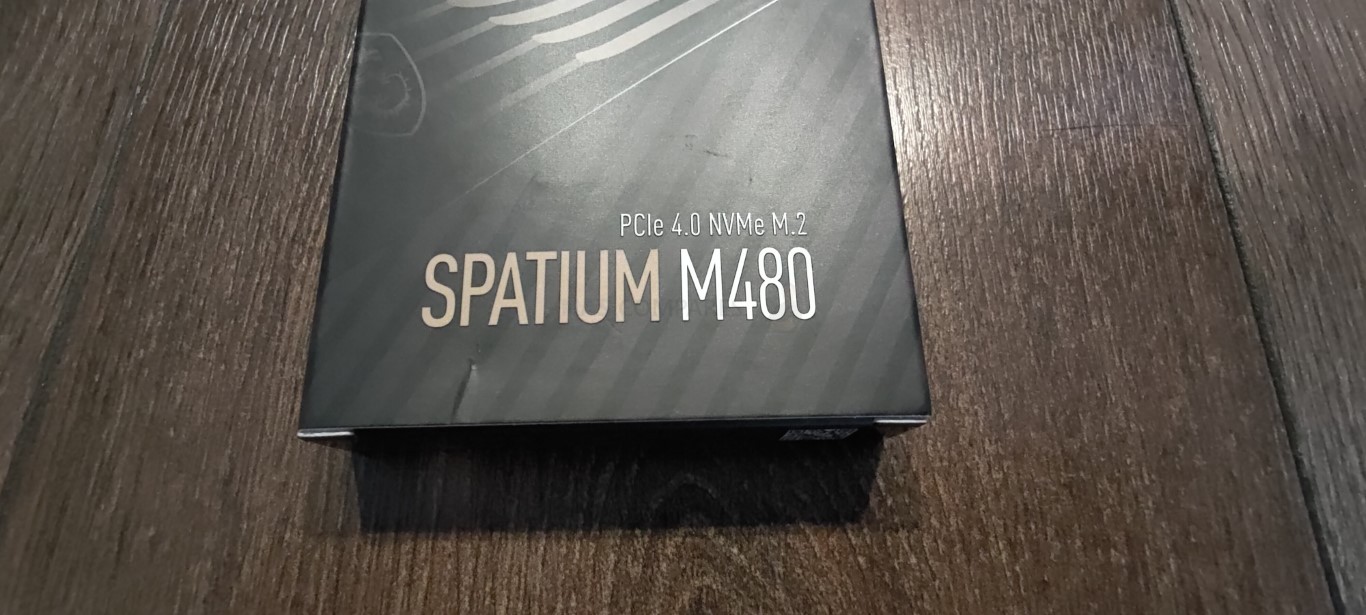
MSI SPATIUM M480 SSD Review – Quick Conclusion
The MSI Spatium M480 SSD is an SSD that, if it had been released even 4-5 months earlier, would have made a much bigger splash than it has. This is not MSI’s fault. The massive range of market damaging events that have plagued the storage market for good or bad in the last 24 months (ranging from the pandemic, semi-conductor shortages, changes in buying trends, US-China trade war, Chia and more) have led to a large number of releases that ordinarily would have been released in a more appropriate/spaced-out manner has led to a downpour of 7,000MB/s SSD releases to hit the market back to back within 3-4 months. Some brands were luckier than others to sneak limited available storage releases at the closing of 2020 and start of 2021 – Looking at you Samsung, WD and Sabrent) and a big result of this is that although the MSI Spatium IS a good SSD that provides EXACTLY what it promises, it does it whilst appearing near identical to about 6 other SSDs from fellow big brands that do the same thing – at a slightly lower price. The MSI Spatium IS a GOOD drive and if you are looking for an NVMe M.2 SSD that can push through more than enough data to largely saturate the potential 8,000MB/s of PCIe 4×4, then this can do it. It is just a little harder to pinpoint what makes this drive stand out from the crowd right now that have similar promises.
MSI SPATIUM M480 SSD Review – Packaging
The packaging is pretty understated, with the drive arriving in a black carton hanging retail slider. The box is quick to highlight that this drive arrives from MSI, with their instantly recognizable logo appearing loud n proud at the top, alongside the promised 7,000MB/s Seq’ Read speed. This is one of the few M.2 PCIe SSD drives that I have reviewed in the last few months that actually downplays the text on the front, with most brands heavily hammering boastful text on the front. They mention the 7,000MB/s reported read – and that’s it.
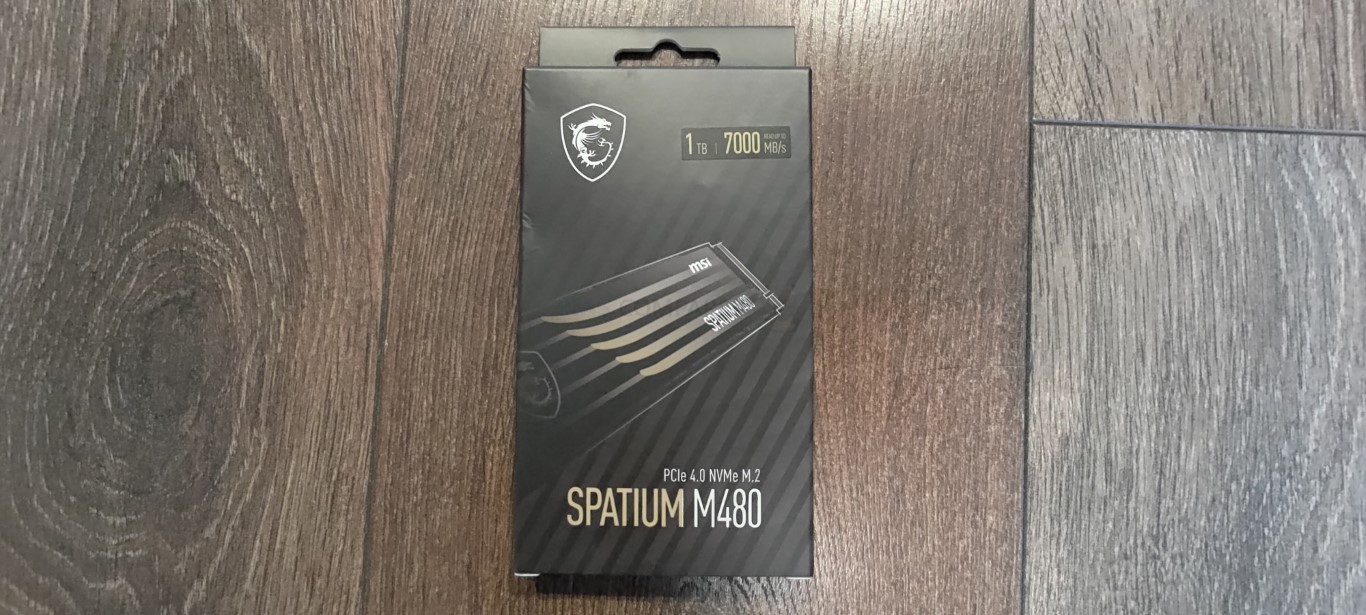
Indeed they don’t even present it with a pile of caveats and exclusions. The read of the box details things more of course, but fair play to the brand for keeping it nice, clear and simple.
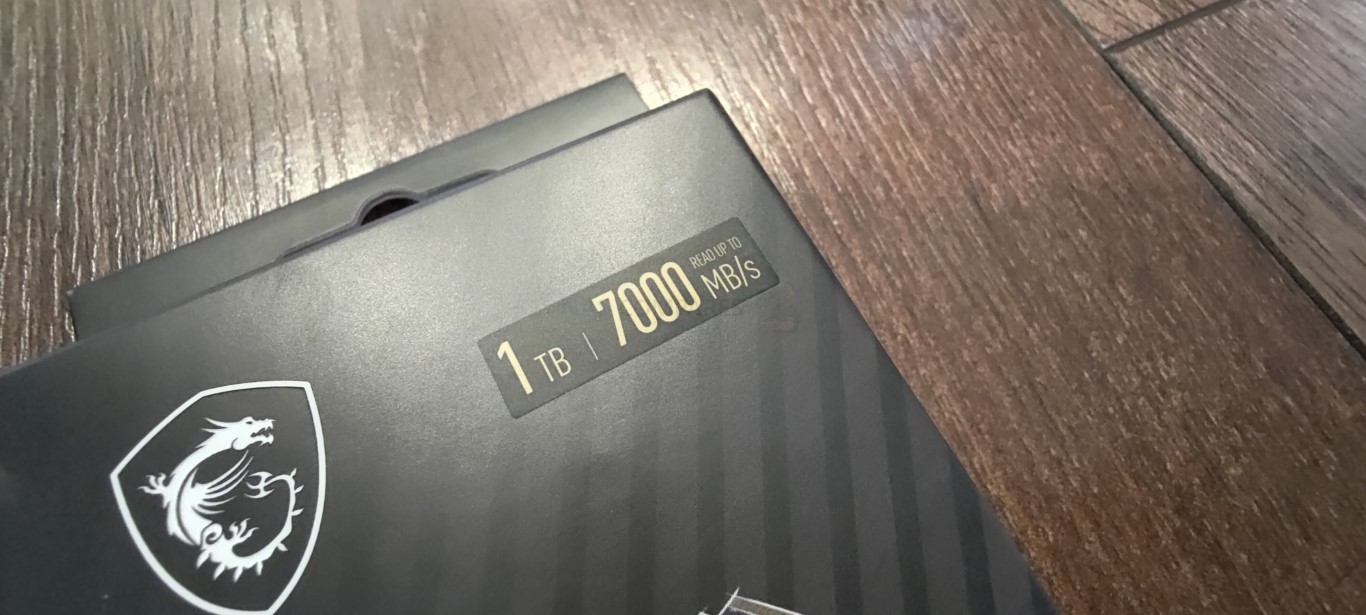
Opening up the retail kit provides suitably simple content. Anyone that has ever purchased an MSI hardware component that they have a huge body of online resources that is the preferred source for assistance and setup guidance, so this does not come as a massive surprise! Inside we find the drive in a sealed surrounding plastic shell and information on the 5 years inclusive warranty and light setup information. For today’s review, we are featuring the 1TB model, but not the 1st party heatsink version that is around $30-35 more.
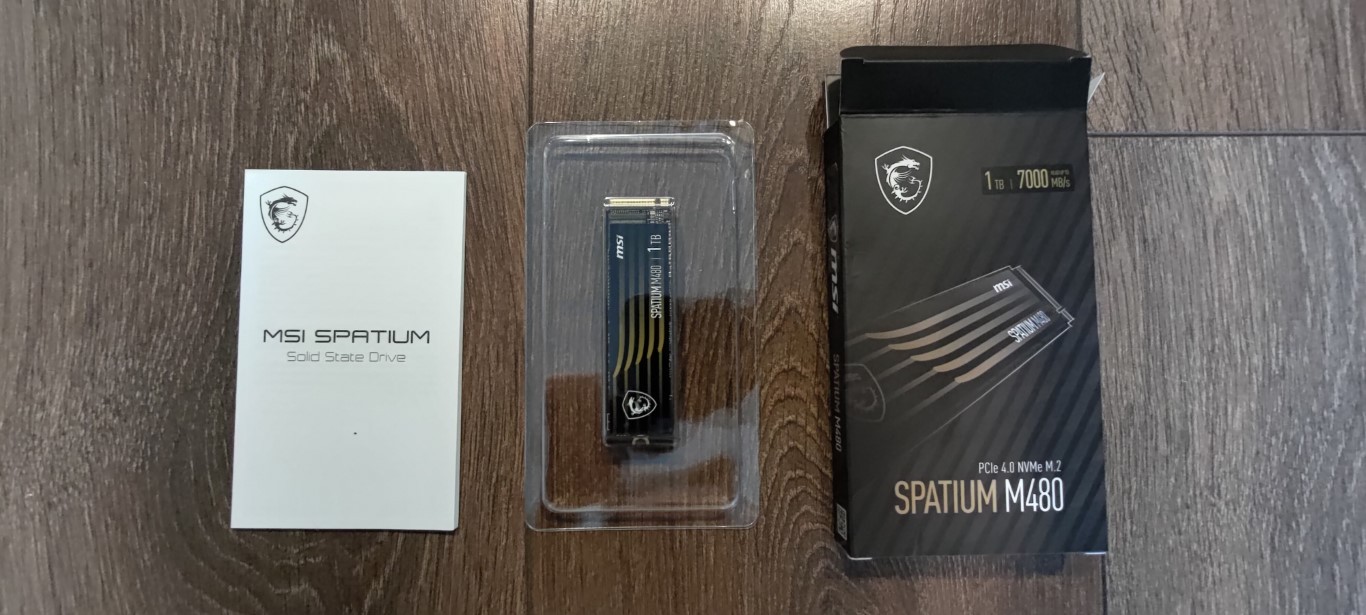
The drive itself arrives with the fairly standard layout for a 1TB. Single-sided NAND/System processors, with a branded label over the top. I am a little sad that it is not a metallic label as you find on the Sabrent Rocket series or even a metal surround as found on the Gigabyte 7000s, but this is all fairly standard otherwise.
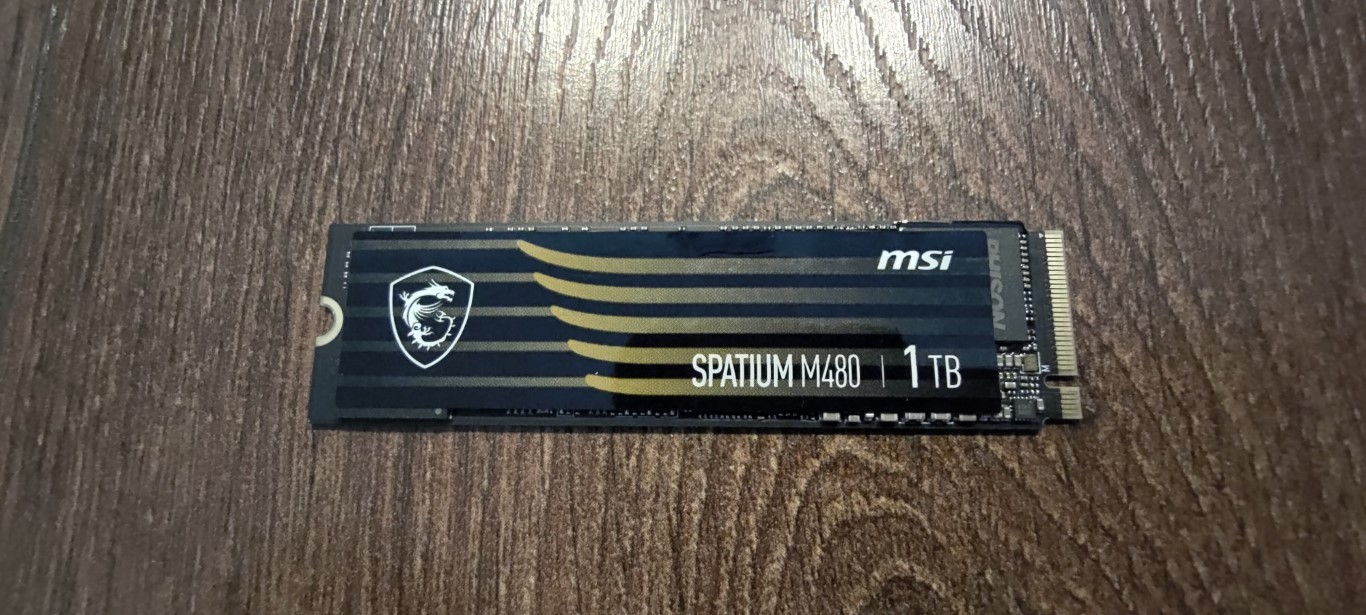
The m.2 connector o this NVMe 1.4 rev drive is nice and clear, without any overhand at the top of the drive. The controller is located right there at the top, so definitely make sure that heatsink and thermal padding you install on this drive when you install it is right up to the top!
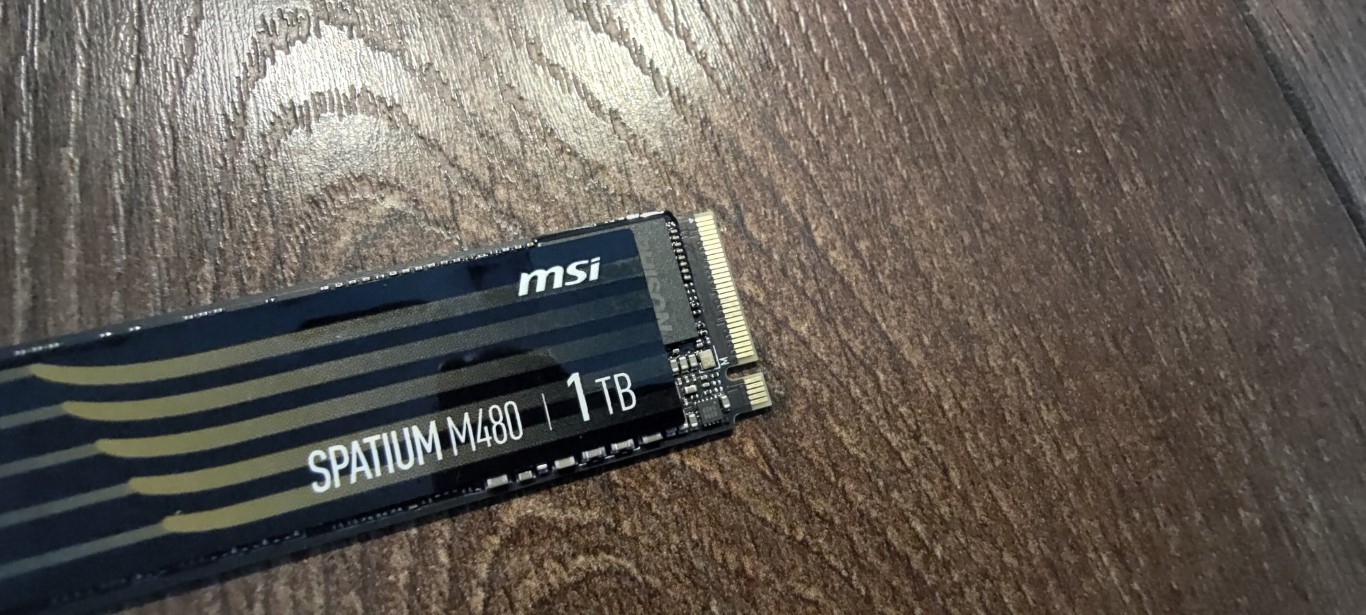
The rear of this single-sided NVMe SSD is pretty standard, detailing the worldwide classifications and utility. Oddly, I noticed the mentioning of warranty support refusal if the label is removed. This is always a peculiar thing, given that many users remove these labels to ensure the connectivity of heatsinks and thermal panels (so they can see the key components are amply covered). This is largely irrelevant in the case of a single-sided 1TB, but I would be interested in how this is addressed and handled in larger versions.
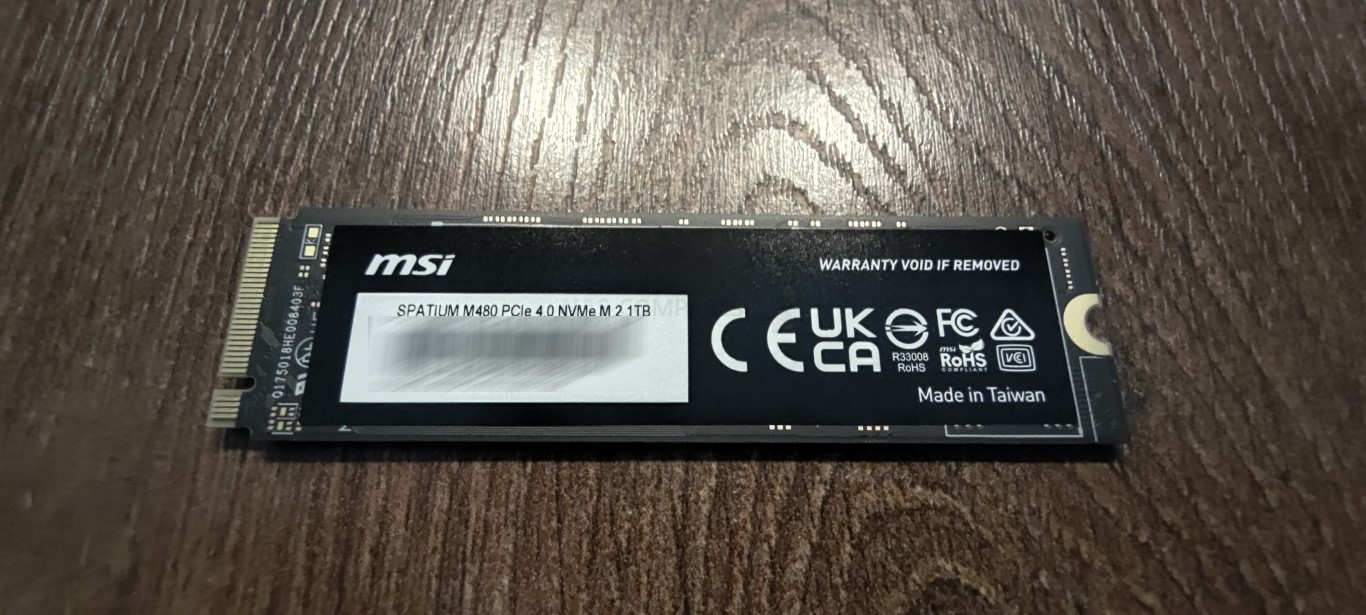
So that is the physical design of the MSI SPATIUM M480 SSD. But what about the hardware components themselves? Does the MSI SPATIUM M480 cut the mustard in terms of current generation hardware and protocols? Let’s find out.
MSI SPATIUM M480 SSD Review – Hardware Specifications
As you might expect from an M.2 NVMe SSD that boldly promises performance of over 7,000MB/s sequential read (ie BIG data), the hardware specifications and architecture of the MSI SPATIUM M480 are quite modern. Indeed, for all the big talk of the Seagate Firecuda 530 hardware (still currently the ‘score to beat’ PCIE Gen4 m.2 NVMe right now) being top tier, the MSI SPATIUM M480 is pretty darn similar on the spec sheet! Below is how it looks:
| MSI SPATIUM M480
|
|
| PCIe Generation | PCIe Gen 4 |
| NVMe Rev | NVMe 1.4 |
| NAND | 3D TLC Micron 96L |
| Max Capacity | 2TB – Single Sided |
| Controller | Phison E18-PS5018 |
| Warranty | 5yr |
I know a lot of the above will seem needlessly technical, so below we can bring the most important considerations into sharper focus.
Hardware Focus of the MSI SPATIUM M480 SSD Series
The first big, BIG thing to remember here is the controller, that Phison E18. An SSD is much like a microcosm version of a whole computer. The Controller is equivalent to the CPU, and Phison are one of the bigger 3rd party SSD controller manufacturers in the world! I say 3rd party, because some long-running storage brands like Samsung and WD have most of their development and hardware engineering ‘in-house’ and use their own branded controllers. Whereas some brands source some/all components for their SSDs from 3rd parties – which is not necessarily a bad thing for both them and the industry (there are pros and cons on either side). Phison has been at the cutting edge of this subject for years now and the E18 was first revealed last year in 2020, but due to the pandemic making storage trends unpredictable and semi-conductor shortages, most SSDs that utilized the Phison E18 eventually arrived in 2021. This controller is one of the biggest reasons that the MSI SPATIUM M480 can actually back up it’s promises about the 7,000MB/s+ Sequential Read (sequential data = big chunks of data). However, that is not the only reason.
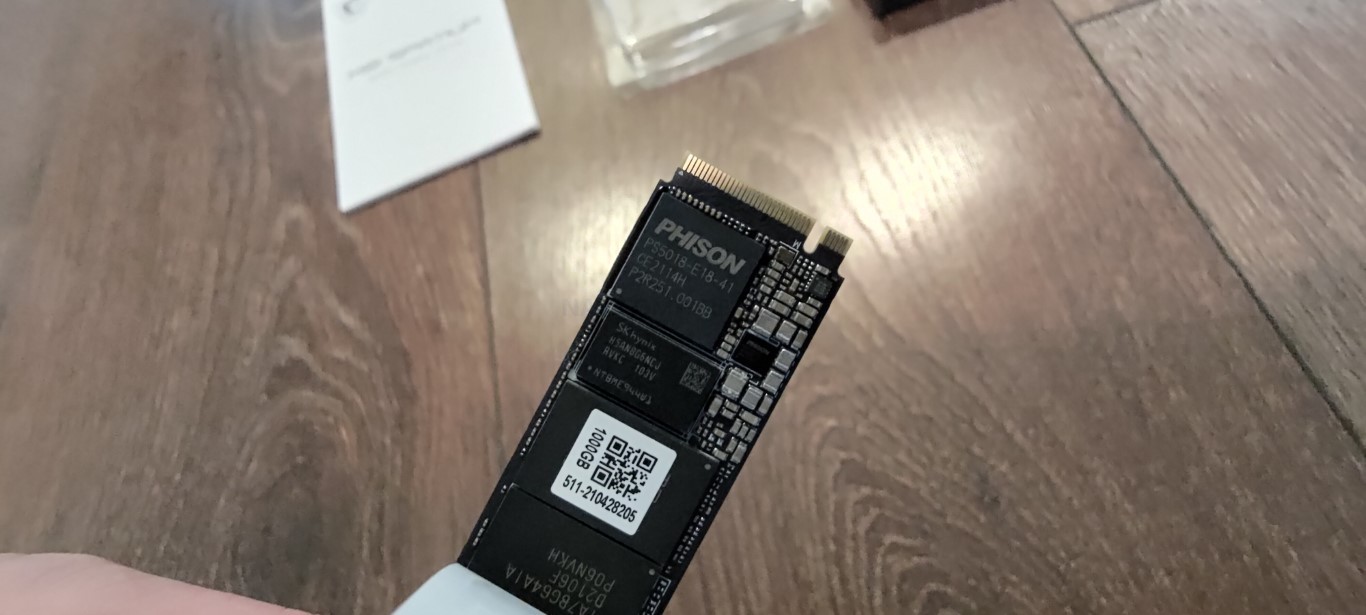
The NAND on the MSI SPATIUM M480 is where the data lives! SSDs (as you no doubt know) do not use moving parts as found in traditional hard drives and instead uses cells that are charged and data is read/written to them in this process. The quality of the NAND and the layers used will make a big difference to the durability and performance of an SSD and although the MSI SPATIUM M480 does not provide the best SSD in the industry at this tier right now (that, once again, goes to the Seagate Firecuda 530 at 176 layer 3D TLC NAND), it is bigger than most, arriving at 96 Layers of 3D TLC NAND. Although the majority of modern PCIe M.2 SSD use 3D TLC NAND (avoid QLC NAND like the PLAGUE btw!), most are still at 64 layers or so, so this is a big jump up for the MSI SPATIUM M480 SSD.
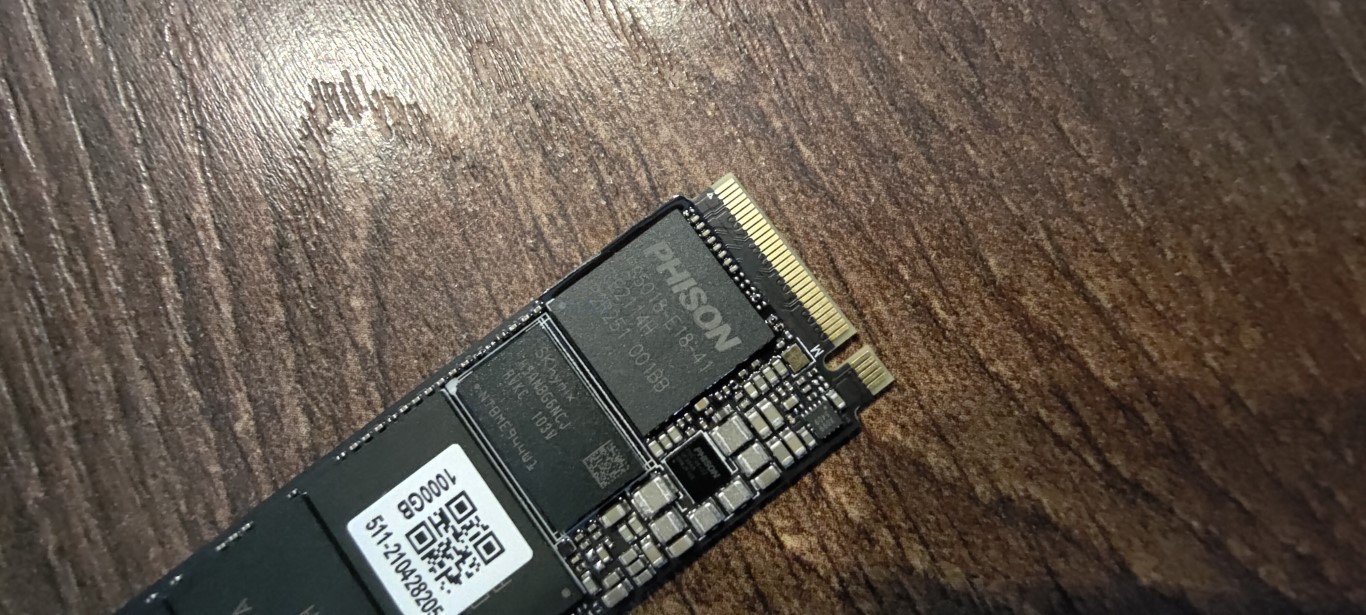
Much like the Controller on the MSI SPATIUM M480 being the ‘CPU’, it also has an area of memory. The MSI SPATIUM M480 SSD uses 1GB DDR4 memory on board and this in conjunction with the SSD provides a massive body of data handling resources for getting your data moving through the SSD and out of the m.2 NVMe PCIe 4 interface. The amount of memory scales in conjunction with the 1TB or 2TB SSD you use, with 2GB of DDR4 at the on the 2TB tier, 1GB DDR4 on the 1TB, etc.
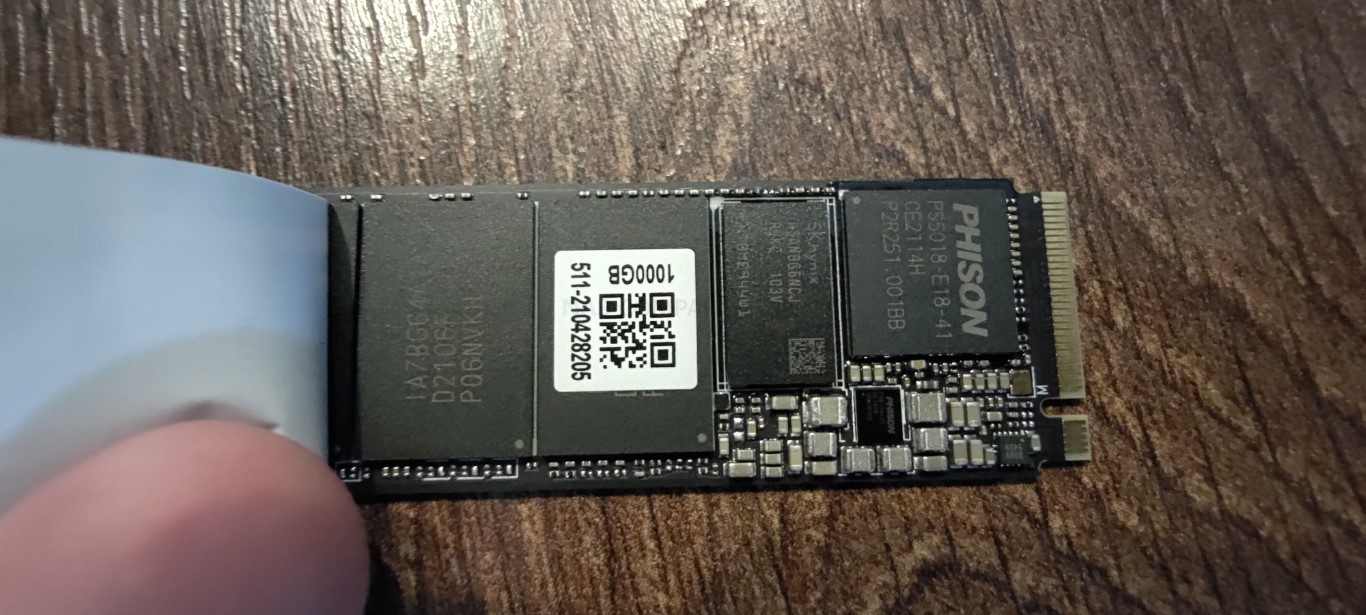
As mentioned, all available capacities of the MSI SPATIUM M480 arrive at 2280 in length. This is quite normal for the 1TB and 2TB versions, but the fact that the 2TB can arrive on single-sided SSD boards is very impressive. Physical storage NAND is distributed evenly in order to space out the storage and allow even cooling, NAND wear and performance. Finally, there is the M.2 NVMe connection. Not all m.2 SSDs are created equal and although M.2 SATA and M.2 NVMe look similar, they provide massively different performance and connectivity. However, the MSI SPATIUM M480 takes it one step further, by using a newer generation of PCIe Connectivity. In short, M.2 NVMe SSDs are connected to the host PC/Console system via PCIe protocol (think of those slots that you almost always use for your graphics cards, but a much, MUCH smaller connector). These allow much larger bandwidth (ie maximum speed) for the connected storage media, Much like regular PCIe slots, they have different versions (i.E PCIe Gen 1, 2, 3, 4, etc) and also a multiplying factor (x1, x2, x4, etc). Up until around 18 months ago, the best M.2 NVMes were M.2 PCIe Gen 3×4 (so a maximum 4,000MB/s possible). However, never generation SSD like the MSI SPATIUM M480 use PCIe Gen 4×4 (a potential 8,000MB/s possible) and it is only now that SSD controllers and NAND production has reached a point where it can catch up and fully saturate (i.e fill) this connection.
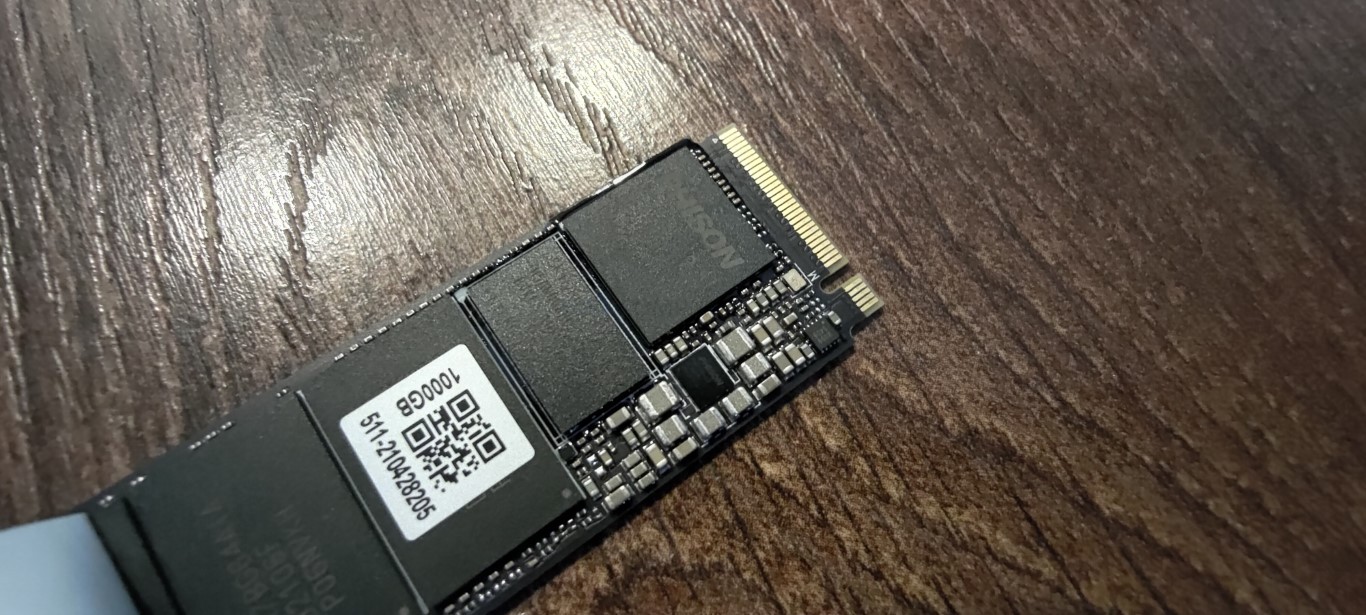
Overall, you really cannot fault the hardware inside/onboard the MSI SPATIUM M480, as it is still (2-3 months after release) higher performing in sequential Read and Write than many other M.2 NVMe PCIe 4 SSDs released in that time. Before we go into the full testing, however, it is worth taking a moment to look closely at the reported performance benchmarks of the MSI SPATIUM M480, as although the performance seems stellar, there are areas such as IOPS and endurance when compared with its main rivals that are worth taking into consideration.
MSI SPATIUM M480 SSD Review – Official Stats First
Before we conduct our own testing on this SSD, Let’s take a closer look at the reported specifications and benchmarks first. The MSI SPATIUM M480 SSD arrives in multiple capacities (below). The Prices currently are a little inconsistent (with each higher capacity tier actually having a higher price per GB – quite unusual) likely due to the hardware shortages, the Pandemic, Chia has affected SSD availability in the last 12 months and most recently the announcement that PS5 supports this SSD and it has increased the current price of both models around 20-30%!. Below is a breakdown of how each MSI SPATIUM M480 SSD compares:
| Brand/Series | MSI SPATIUM M480
|
Seagate Firecuda 530
500GB – $149.99, 1TB – $239.99, 2TB – $489.99, 4TB – $949.99 |
WD Black SN850
|
| PCIe Generation | PCIe Gen 4 | PCIe Gen 4 | PCIe Gen 4 |
| NVMe Rev | NVMe 1.4 | NVMe 1.4 | NVMe 1.4 |
| NAND | 3D TLC Micron 96L | 3D TLC Micron B47R 176L | BiCS4 96L TLC |
| Max Capacity | 2TB – Single Sided | 4TB – Double Sided | 2TB |
| Controller | Phison E18-PS5018 | Phison E18-PS5018 | WD_BLACK G2 |
| Warranty | 5yr | 5yr | 5yr |
| 500GB Model | M480-500G | ZP500GM3A013 | WDS500G1X0E-00AFY0 |
| Price in $ and $ | $119 / £99 | $139 / £119 | $119 / £99 |
| 1TB Model | M480-1000G | ZP1000GM3A013 | WDS100T1X0E-00AFY0 |
| Price in $ and $ | $225 / £185 | $239 / £199 | $249 / £169 |
| 2TB Model | M480-2000G | ZP2000GM3A013 | WDS200T1X0E-00AFY0 |
| Price in $ and $ | $435 / £364 | $419 / £379 | $399 / £339 |
| 4TB Model | N/A | ZP4000GM3A013 | N/A |
| Price in $ and $ | N/A | $949 / £789 | N/A |
| 500GB Model | N/A | ZP500GM3A013 | WDS500G1X0E-00AFY0 |
| Total Terabytes Written (TBW) | N/A | 640TB | 300TB |
| Mean Time Between Failures (MTBF, hours) | N/A | 1,800,000 | 1,750,000 |
| DWPD | N/A | 0.7DWPD | 0.3DWPD |
| 1TB Model | M480-1000G | ZP1000GM3A013 | WDS100T1X0E-00AFY0 |
| Total Terabytes Written (TBW) | 700TB | 1275TB | 600TB |
| Mean Time Between Failures (MTBF, hours) | 1,700,000 | 1,800,000 | 1,750,000 |
| DWPD | 0.38DWPD | 0.7DWPD | 0.3DWPD |
| 2TB Model | M480-2000G | ZP2000GM3A013 | WDS200T1X0E-00AFY0 |
| Total Terabytes Written (TBW) | 1400TB | 2550TB | 1200TB |
| Mean Time Between Failures (MTBF, hours) | 1,700,000 | 1,800,000 | 1,750,000 |
| DWPD | 0.38DWPD | 0.7DWPD | 0.3DWPD |
| 4TB Model | N/A | ZP4000GM3A013 | N/A |
| Total Terabytes Written (TBW) | N/A | 5100TB | N/A |
| Mean Time Between Failures (MTBF, hours) | N/A | 1,800,000 | N/A |
| DWPD | N/A | 0.7DWPD | N/A |
There are clear throughput improvements as you rise through the capacity tiers (not unusual), as does the rated 4K IOPS. Though one area worth focusing on a little is that TBW (terabytes Written) and DWPD (Drive writes per day), as this drive is rated a pinch higher than the Samsung 980 Pro and WD Black SN850 in terms of NAND lifespan on daily writes, likely down to that Micron 96 Layer 3D TLC NAND used, rather than t used by those used by competitors. This is an important point because the brand has significantly less pedigree in-home/business SSD media than the likes of Samsung, WD and Seagate and people will want to know they are going to get a product that lasts!
However, despite the use of the Phison E18 controller and 96 layer NAND, the reported IOPS on each capacity is actually a noticeable degree lower than those reported by their competitors. Indeed, the MSI SPATIUM M480 is one of the few E18 SSDs that does not cross into the reported 1 Million IOPS mark, maxing out at 700k. This is still very impressive anyway, but it does make me wonder where the disparity stems from. Indeed, when you look at the bulk of PCIe 4×4 M.2 NVMe 1.4 SSD, that feature the E18 controller and 96L (or higher) on board, it really only leaves about 4 other SSDs in the market today that this can be compared against. The Sabrent Rocket 4 Plus, the MSI Spatium M480, the ADATA Gammix S70 and (current leader) the Seagate Firecuda 530. Of those, the only one that seemingly ‘out specs’ the MSI SPATIUM M480 is the Seagate Firecuda 530. However, the MSI SPATIUM M480 SSD has been available in the market for almost 3-4 months longer and has certainly embedded itself in the market at that time a fraction more. Below is how these two drives compare:
| Brand/Series | MSI SPATIUM M480
|
Seagate Firecuda 530
500GB – $149.99, 1TB – $239.99, 2TB – $489.99, 4TB – $949.99 |
WD Black SN850
|
| 500GB Model | N/A | ZP500GM3A013 | WDS500G1X0E-00AFY0 |
| Sequential Read (Max, MB/s), 128 KB | N/A | 7000MB | 7000MB |
| Sequential Write (Max, MB/s), 128 KB | N/A | 3000MB | 4100MB |
| 1TB Model | M480-1000G | ZP1000GM3A013 | WDS100T1X0E-00AFY0 |
| Sequential Read (Max, MB/s), 128 KB | 7000MB | 7300MB | 7000MB |
| Sequential Write (Max, MB/s), 128 KB | 5500MB | 6000MB | 5300MB |
| 2TB Model | MP600-2TB | ZP2000GM3A013 | WDS200T1X0E-00AFY0 |
| Sequential Read (Max, MB/s), 128 KB | 7000MB | 7300MB | 7000MB |
| Sequential Write (Max, MB/s), 128 KB | 6550MB | 6900MB | 5100MB |
| 4TB Model | N/A | ZP4000GM3A013 | |
| Sequential Read (Max, MB/s), 128 KB | N/A | 7300MB | N/A |
| Sequential Write (Max, MB/s), 128 KB | N/A | 6900MB | N/A |
| Brand/Series | MSI SPATIUM M480 | Seagate Firecuda 530 | WD Black SN850 |
| 500GB Model | N/A | ZP500GM3A013 | WDS500G1X0E-00AFY0 |
| Random Read (Max, IOPS), 4 KB QD32 | N/A | 400,000 | 1,000,000 |
| Random Write (Max, IOPS), 4 KB QD32 | N/A | 700,000 | 680,000 |
| 1TB Model | M480-1000G | ZP1000GM3A013 | WDS100T1X0E-00AFY0 |
| Random Read (Max, IOPS), 4 KB QD32 | 360000 | 800000 | 1,000,000 |
| Random Write (Max, IOPS), 4 KB QD32 | 780000 | 1000000 | 720,000 |
| 2TB Model | M480-2000G | ZP2000GM3A013 | WDS200T1X0E-00AFY0 |
| Random Read (Max, IOPS), 4 KB QD32 | 660,000 | 1,000,000 | 1,000,000 |
| Random Write (Max, IOPS), 4 KB QD32 | 800,000 | 1,000,000 | 710,000 |
| 4TB Model | N/A | ZP4000GM3A013 | |
| Random Read (Max, IOPS), 4 KB QD32 | N/A | 1,000,000 | N/A |
| Random Write (Max, IOPS), 4 KB QD32 | N/A | 1,000,000 | N/A |
Yes, that is a LONG table, but you can immediately see that the Seagate Firecuda 530 raises the stakes on all of the key specifications. Although there are a number of micro reasons for this, the 176L NAND is the biggest factor here. Yes, that is why the Firecuda 530 commands the higher price tag. Additionally, the WD Black arriving at a better price point, higher IOPS in most tiers and the fact it does this whilst still hitting that 7,000MB/s certainly gives pause for thought. However, for many, the additional cost for higher durability they may never need, peak performance their core system will not reach and IOPS rating that their larger file handling will never utilize will mean that holding out for the Firecuda or WD Black SN850 is not in their interest. Both SSDs (on paper at this stage!) are fantastic examples of where consumer and prosumer SSDs are evolving towards. Let’s get the MSI SPATIUM M480 on the test machine!
Testing the MSI SPATIUM M480 m.2 PCIE4 NVMe SSD
The MSI SPATIUM M480 was selected for this test and it was tested using multiple benchmark tools, from a cold boot, in the 2nd storage slot (i.e not the OS drive). Each test was conducted three times (full details of this are shown in the YouTube Review of the MSI SPATIUM M480 over on NASCompares):
Test Machine:
- Windows 10 Pro Desktop System
- Intel i5 11400 Rocket Lake – 6-Core 2.6/4.4Ghz
- 16GB DDR4 2666MHz Memory
- Intel B560M mATX Motherboard
- OS Storage, Seagate Firecuda 120 SSD
- Test SSD connected to Secondary PCIe Gen 4 M.2 Slot
Using CrystalDisk, we got a good measure of the drive and verified that this PCIe Gen 4 x4 SSD was indeed using the 4×4 lane. Additionally, the temp averaged out around 43C between each test being conducted.

The first tests were conducted using the ATTO disk benchmark software. The first was a 256MB test file size and below is a breakdown of the transfer rates and IOPS. The 2nd Test was a 1GB test file and finally, the last test was with a 4GB test file. The system was given 1-minute cool downtime between tests, no screen recording software was used (remove overhead) and a heatsink was used throughout (no reboots)
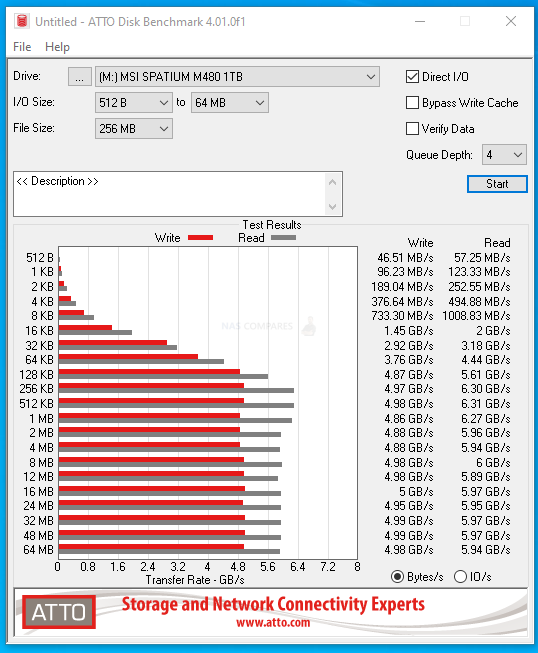 |
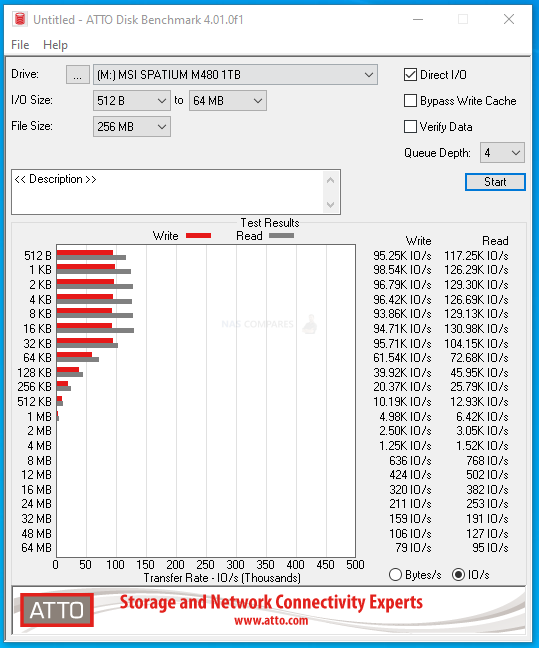 |
ATTO Disk Benchmark Test #1
256MB File PEAK Read Throughput = 6.31GB/s
256MB File PEAK Write Throughput = 5GB/s
 |
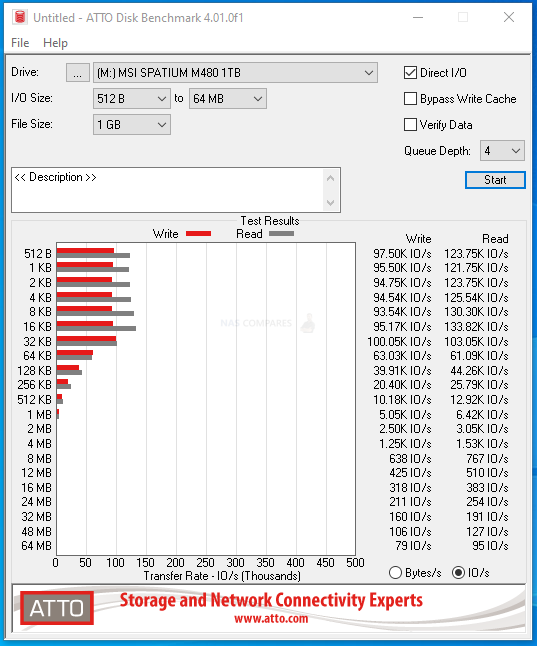 |
ATTO Disk Benchmark Test #2
1GB File PEAK Read Throughput = 6.31GB/s
1GB File PEAK Write Throughput = 5GB/s
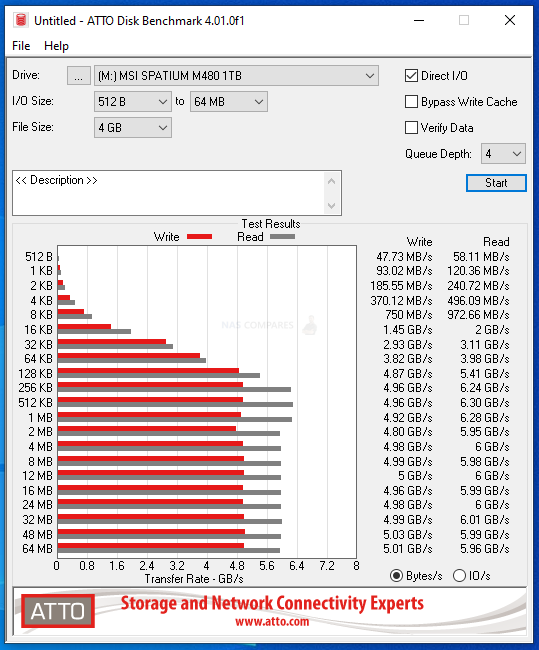 |
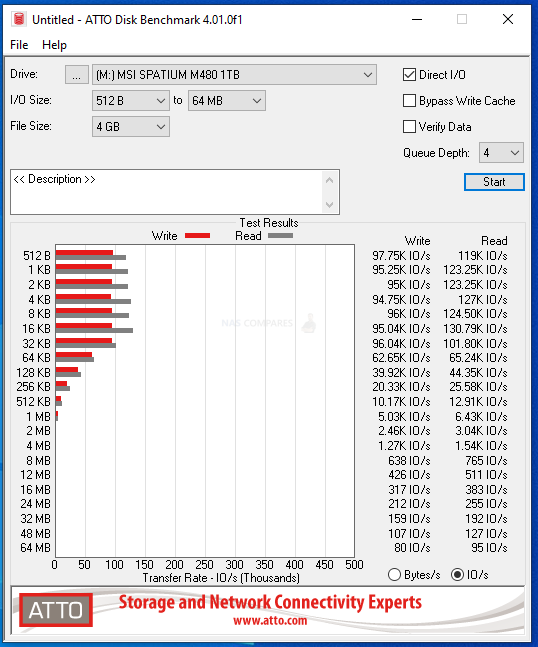 |
ATTO Disk Benchmark Test #3
4GB File PEAK Read Throughput = 6.30GB/s
4GB File PEAK Write Throughput = 5.03GB/s
Next, although the ATTO tests were quite good, but not what I would have hoped from this SSD, so I moved on to the Crystal Disk Mark testing to see how well it would handle our lasts barrage of tests. The first test was the 1GB file testing, which measured both sequential and random, as well as the read and write IOPS. Test were conducted on a 1GB, 4GB and 16GB Test File. I also included a mixed 70/30 read and write task to give a little bit more of a realistic balanced workload. These tests were conducted with 1-minute cooling break in between
CRYSTALDISK MARK 1GB TEST
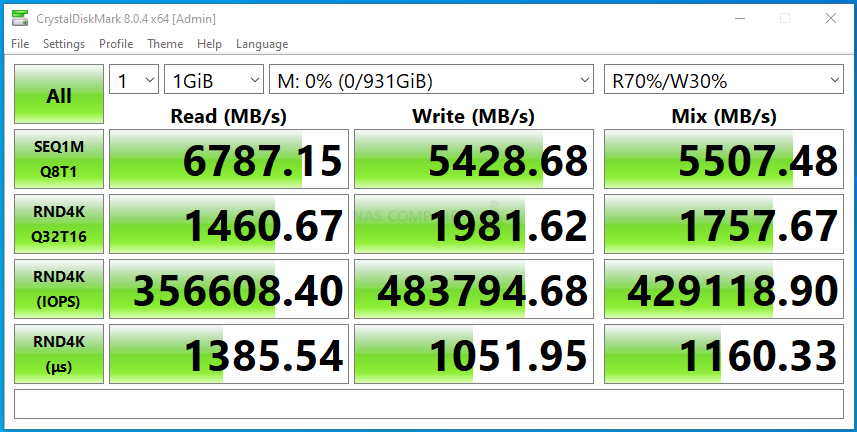
CRYSTALDISK MARK 4GB TEST
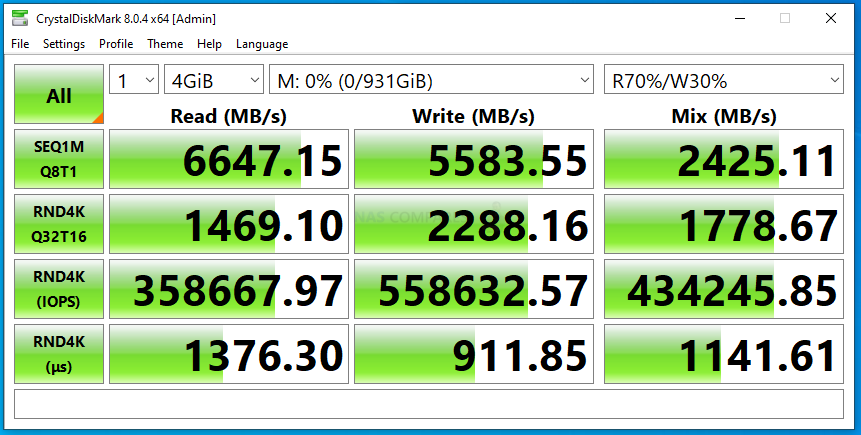
CRYSTALDISK MARK 16GB TEST
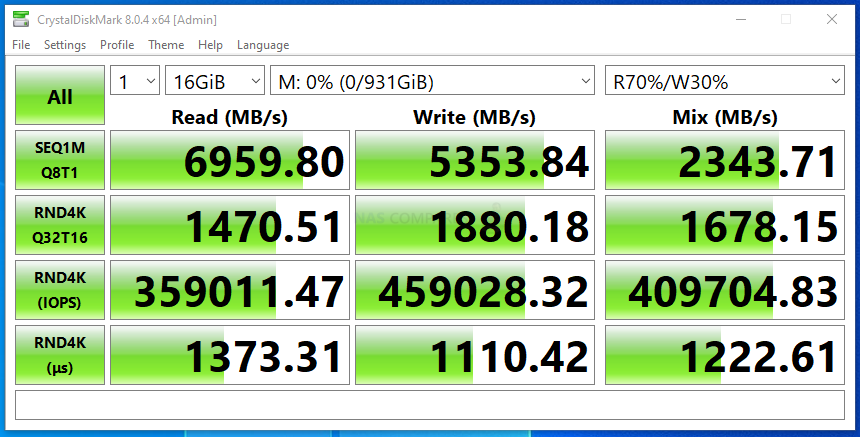
Next, I switched to AS SSD benchmark. A much more thorough test through, I used 1GB, 3GB and 5GB test files. Each test includes throughput benchmarks and IOPS that are respective to the larger file sizes (important, if you are reading this and trying to compare against the reported 4K IOPS from the manufacturer).
AS SSD Benchmark Test #1
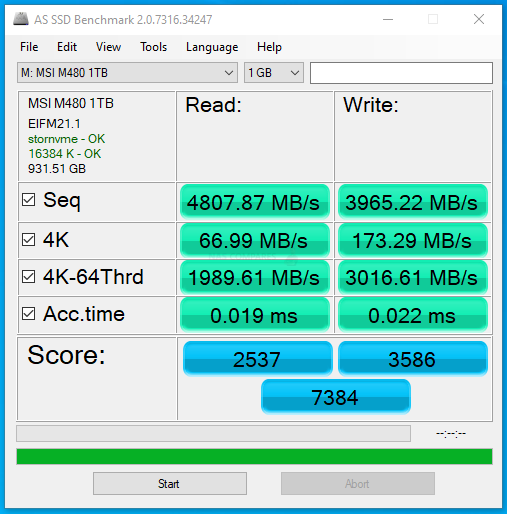 |
 |
AS SSD Benchmark Test #2
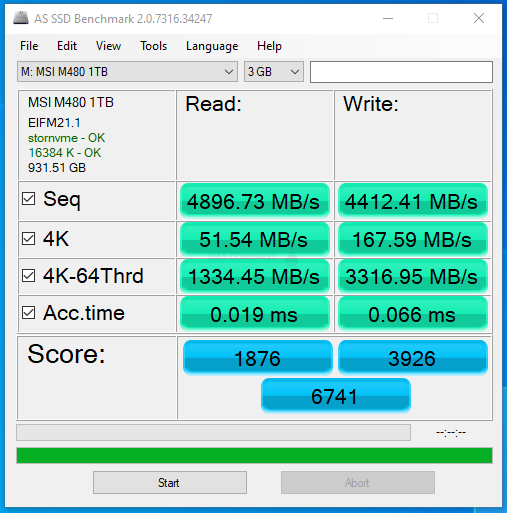 |
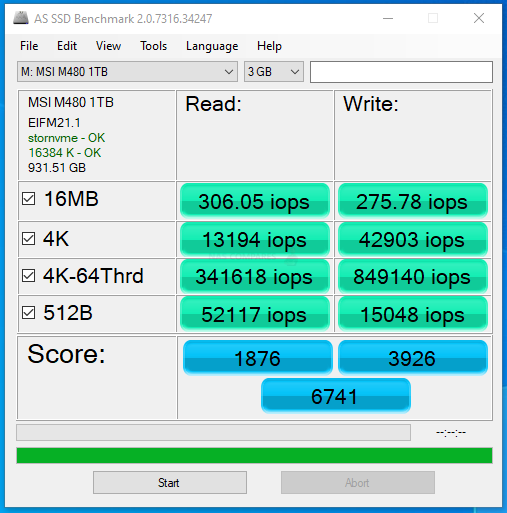 |
AS SSD Benchmark Test #3
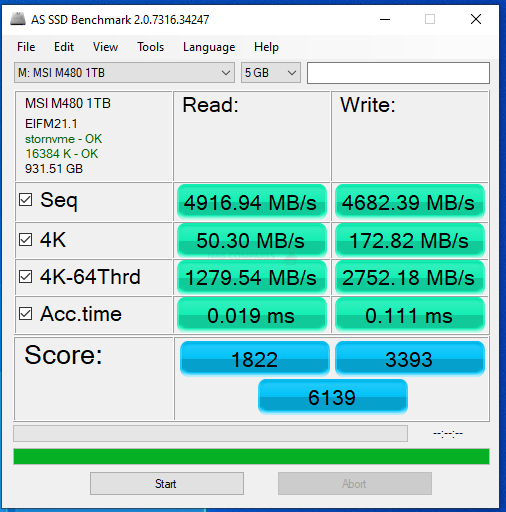 |
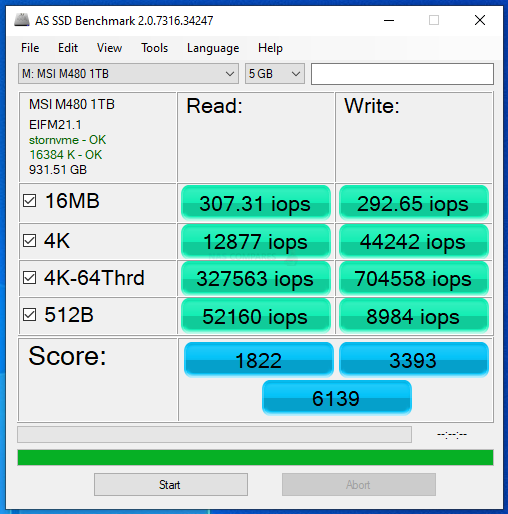 |
Ordinarily, I would introduce tests like BlackMagic and AJA into the mix here, but even a short burst of testing on an NVMe like this would over saturate the cache memory on board. Nevertheless, in the short term we still could ascertain the reported performance on 1GB, 4GB and 16GB file testing was:
1GB AJA File Test Results (Peak) = 5356MB/s Read & 5855MB/s Write

4GB AJA File Test Results (Peak) = 5313MB/s Read & 5835MB/s Write

16GB AJA File Test Results (Peak) = 5383MB/s Read & 5855MB/s Write

Overall, the MSI SPATIUM M480 was certainly able to provide some solid performance, as well as potentially exceed the test figures here on a more powerful machine. Given the reported Read and Write statistics that the brand has stated publically, I think there is enough evidence here to back up those claims. IOPs were a little lower than I expected, but again, we were testing very large file types, so this would have to be taken in context.
MSI SPATIUM M480 SSD Review – Conclusion
The MSI Spatium M480 SSD is an SSD that, if it had been released even 4-5 months earlier, would have made a much bigger splash than it has. This is not MSI’s fault. The massive range of market damaging events that have plagued the storage market for good or bad in the last 24 months (ranging from the pandemic, semi-conductor shortages, changes in buying trends, US-China trade war, Chia and more) have led to a large number of releases that ordinarily would have been released in a more appropriate/spaced-out manner has led to a downpour of 7,000MB/s SSD releases to hit the market back to back within 3-4 months. Some brands were luckier than others to sneak limited available storage releases at the closing of 2020 and start of 2021 – Looking at you Samsung, WD and Sabrent) and a big result of this is that although the MSI Spatium IS a good SSD that provides EXACTLY what it promises, it does it whilst appearing near identical to about 6 other SSDs from fellow big brands that do the same thing – at a slightly lower price. The MSI Spatium IS a GOOD drive and if you are looking for an NVMe M.2 SSD that can push through more than enough data to largely saturate the potential 8,000MB/s of PCIe 4×4, then this can do it. It is just a little harder to pinpoint what makes this drive stand out from the crowd right now that have similar promises.

| PROs of the MSI SPATIUM M480 | CONs of the MSI SPATIUM M480 |
| Genuinely Impressive Performance
PS5 Compatibility Confirmed 96 Layer TLC 3D NAND Higher Durability than WD Black & Samsung 980 Pro More affordable than the Seagate Firecuda 530 Consistent 7,000MB/s on ALL Capacities |
The heatsink isn’t included and run rather hot!
IOPS figures are lower than many PCIe4 SSDs
|
🔒 Join Inner Circle
Get an alert every time something gets added to this specific article!
This description contains links to Amazon. These links will take you to some of the products mentioned in today's content. As an Amazon Associate, I earn from qualifying purchases. Visit the NASCompares Deal Finder to find the best place to buy this device in your region, based on Service, Support and Reputation - Just Search for your NAS Drive in the Box Below
Need Advice on Data Storage from an Expert?
Finally, for free advice about your setup, just leave a message in the comments below here at NASCompares.com and we will get back to you. Need Help?
Where possible (and where appropriate) please provide as much information about your requirements, as then I can arrange the best answer and solution to your needs. Do not worry about your e-mail address being required, it will NOT be used in a mailing list and will NOT be used in any way other than to respond to your enquiry.
Need Help?
Where possible (and where appropriate) please provide as much information about your requirements, as then I can arrange the best answer and solution to your needs. Do not worry about your e-mail address being required, it will NOT be used in a mailing list and will NOT be used in any way other than to respond to your enquiry.

|
 |
The Best Bits (and Worst Bits) of NAS of 2025!
Minisforum MS-02 Ultra Review
Minisforum N5 NAS, 6 Months Later - Better, Worse, the Same?
Beelink ME Pro NAS Revealed
Best SOLID STORAGE NAS of 2025
Should You Worry About the NanoKVM Hidden Microphone?
Access content via Patreon or KO-FI





Discover more from NAS Compares
Subscribe to get the latest posts sent to your email.


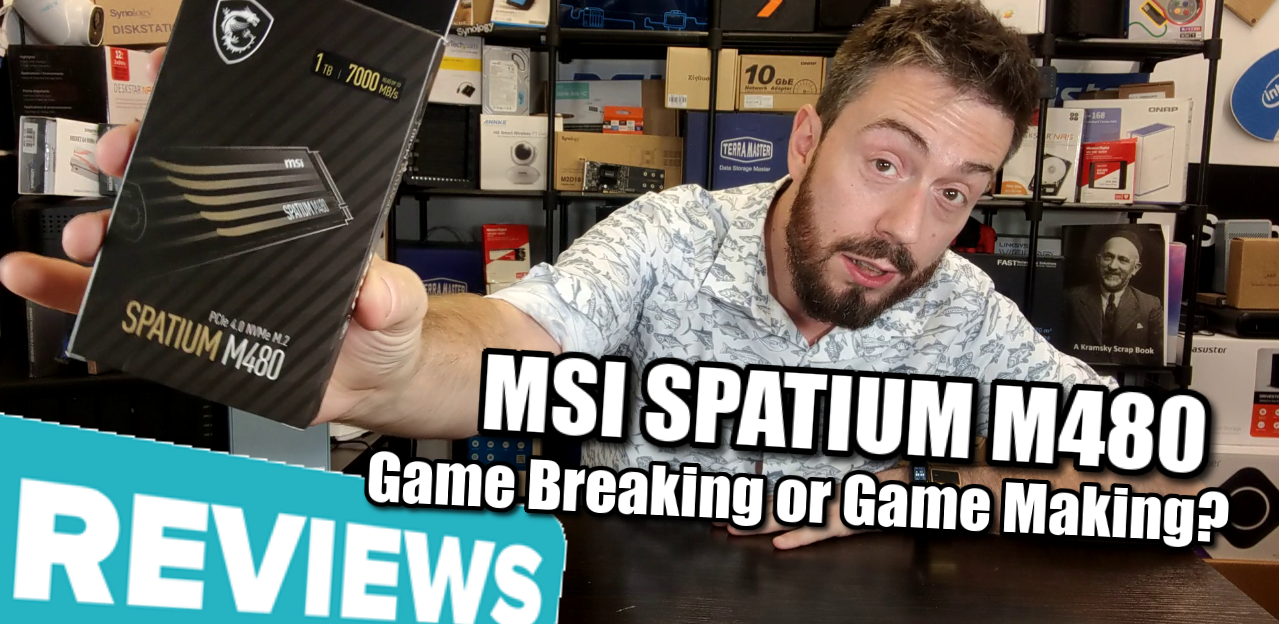







A really good & detailed video ????
REPLY ON YOUTUBE
I just ordered this recently off of Walmart’s website remind me to stick this in my new laptop that I’m getting on my birthday, I’ll run an update and let you guys know if it’s worth it or not, though I got a 2TB
REPLY ON YOUTUBE
Speak English. One than can be understood by non computer people
REPLY ON YOUTUBE
I bought this 1 month ago and it performs worse than my Hard Disk!! Its full of crap SSD!!! don’t buy it … this YouTuber probably got money from MSI
REPLY ON YOUTUBE
nice teeth jerk
REPLY ON YOUTUBE
M480 & m480 pro are they same?
REPLY ON YOUTUBE
He said Tiny4k
REPLY ON YOUTUBE
This is RAM or a SSD? :))
REPLY ON YOUTUBE
MSI needs to release a new version of this with some RGB!!!!
REPLY ON YOUTUBE
When i saw this boot drive review it changed my mind : https://www.youtube.com/watch?v=v0UGUYfYCWc
REPLY ON YOUTUBE
Have DRAM CACHE?
REPLY ON YOUTUBE
7 GB read, 6.8 GB write. Boy, this thing can push any machine to godspeed.
REPLY ON YOUTUBE
I sent MSI my MB CPU and memory after the MB shorted and caught fire. I talked to Tom Ho and told him I’m sending the vag card with the MB, CPU, mem. i just got the vga card and nothing else. They said they never had received the rest of the parts. Not true. So I’m sitting here with an empty case after a few months of arguing with customer service. July now September. Well my 15 year old computer died today and I’m forced to buy a new MB and CPU and memory to fill the empty MSI case I have. It will be filled with Asus products as their products are professional grade and don’t burn up, like the new MSI motherboard did to me. Must have been a short in the design a long time ago but still sold the crap to consumers
MSI,
Enjoy the free burnt up MB and damaged memory and CPU your company wanted to hide and keep, to hold so tight, like as of it was worth anything at all. Poorly made and useless to anyone. You can’t stop me from posting bad reviews about your customer service and the poor quality products your company sells. It’s already tanking and you will all have to find a new job soon.
REPLY ON YOUTUBE
I have the choice between this one and crucial p5 plus (same price) what should i choose, this one is faster but does the crucial better memory control and things?
REPLY ON YOUTUBE
I learned so much! Great review!
REPLY ON YOUTUBE
Crap product. I’ve installed 2 of them on 3 different compatible computers and they aren’t recognized. I’m not the only one seeing this.
REPLY ON YOUTUBE
Very nice I’m gonna grab 2 of 2TB drives as an upgrade and replacement of my sata 3 ssd drives. 🙂
REPLY ON YOUTUBE
Why would-be you want a heatsink its nog needed at all
REPLY ON YOUTUBE